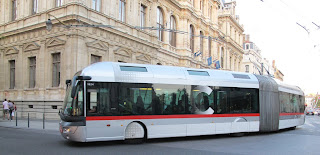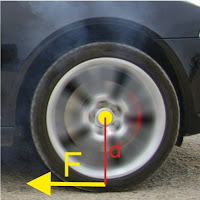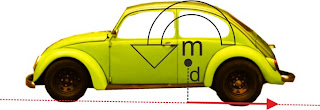This post is located into desk section. We're going to outlook basic concepts about force and torque. As a blog reader you may have questions like:
- What is this for?: The objective is to understand easy ideas that allow to answer complex questions in the future.
- But this is a blog about electric cars, hybrids, alternative fuel cars and technology improvements on vehicles, isn’t it?: Yes, but understanding basic concepts is interesting in order to solve many doubts in the future.
- Am I going to get bored?: I hope you won't, but in case it happens you should stop reading and try it later or when basic ideas contained in this post are exposed in others.
- Are there any prerequisites?, I mean, should I know how integrate, have been in Wyoming or have met Paris Hilton?: Absolutely not, but there is no problem if you have.
- Is the real post going to start right now or are you going on with this bullshit?: We'll start right now.
May the force be with you.
We have to go backwards in time to 200 years before mr. Karl Benz built the first automobile, to 1687. In that year, Sir Isaac Newton put the basis of classic mechanics and introduced a trilogy of laws that still model car dynamics. They work ok if we stay away from light speed, as indeed we are, because faster production cars have a top speed near 250 mph, far from 180,000 [miles/s].
A force is defined as “cause able to modify rest or motion state of an object or distort it” [1].
The 3 Newton laws are as simple as true:
- Inertia law: It stands that any object at rest or constant linear motion will go on with its previous state if there is no force applied on it. A vehicle at constant speed or at rest will go on in that state while a force is not applied [2]. Many forces are usually acting over a moving car, as shown on next point.

- Force law: Motion intensity is modified when a force is applied, proportionally and on the same line in which the force is applied. V0 speed will increase in case a force is applied on the same direction and will decrease when speed an force have opposite directions. Acceleration on the vehicle will always be generated with F=m·a and will be responsible of the speed change on the vehicle. In a real vehicle on flat surface, the engine is the cause of increasing speed and speed decrease is generated by the braking system, aerodynamic drag, rolling resistance and engine brake (a combination of air pumping work into the cylinders, mechanical losses, and accessories power consumption, as alternator or water pump…). These actions against movement have different intensities depending on conditions as speed, engine revs, pavement, tire pressure…


- Action and reaction law: Any action always generates other, equal and acting in opposite direction. Action and reaction effect is clear in a perfectly elastic collision. Magnitudes acting over a car are labeled in its color. Yellow car, with V0 speed, collides with the v=0 green one. Yellow car gives its kinetic energy as a F force over green car. As a reaction, green car generates an equal force F over yellow car. Final scenario is composed by yellow car at rest and green car moving with v0 speed. In a real case a crash is not a perfectly elastic collision, but it’s ok to illustrate the third Newton law.



Give me a moment
Two parallel forces not collinear with opposite directions is a particular case on automobile. In those conditions a moment or torque is generated over an equidistant point.
On previous figure a moment M=F·d is generated, with units of force by distance, usually [N·m], [kg·m] or [lbf·ft] (imperial system). Latter two examples are kilopond (or kilogram-force) and pound-force. Both of them are force units: the weight of these mass under gravity acceleration (9.8 [N] approx.). Force transmitted through spin can be evaluated, so it’s an interesting magnitude for engines or transmission elements.
This magnitude, in a real case, is a force related to the distance to a spin point.
A wheel during acceleration can be seen on previous image [3]. A friction force F is being transmitted to pavement by the wheel. Pavement generates an opposite and equal force by action and reaction law, which is transferred to the center of the wheel and moves the vehicle.
Engine torque is related to rpm and engine load (a function of throttle position). For a constant torque at fixed rpm, transmission allows to get a different torque on the wheels changing their rotational speed. When a lower gear is selected a higher torque is put into the wheels while speed is reduced. When a higher gear is selected, speed increases but the wheels torque is reduced. In both examples the engine torque is constant.
Wheel force on pavement varies with wheel external radius. A bigger radius mean a bigger circumference and more path per wheel revolution l=2·pi·r in the same gear and rpm. But also a lower force is put on the pavement due to the same torque and a bigger radius. Also a higher torque at lower speed is generated with a lower wheel radius. In Spain up to a 3% variation from original values is allowed.
Force propelling the vehicle is constant at constant engine torque, rpm and gear (not considering other forces such as wind and on flat terrain). Instantaneous fuel consumption is also constant in that scenario. Newton's second law means that acceleration can be written as: a=F/m, so we'll get a bigger acceleration with a lower mass. That is one of the benefits of weight reduction on vehicles, but dynamic behavior is improved too.
Never stop playing.
Now we'll figure out how to apply aforementioned concepts to car dynamics. How and when to brake, tire grip ellipse and managing car weight are three basic concepts related to car dynamics, especially on sport driving. If you are familiar with driving simulators or you have driven a car in a circuit, you probably know that weight management is important (not only for sports driving) and that a higher mass needs bigger forces to achieve the same acceleration.
Car weight can be modeled as confined in a point called "mass center". Newton's first law means that this point will keep rest or constant linear motion, in opposition to forces on tires, both longitudinal (accelerating or braking) or transversal (turning). This means that mass center will move to front when braking, backwards when accelerating and to the exterior side of the road in turns (this tendency generates an imaginary force called centrifugal force, which is against real force on tires, called centripetal force). So, tires where mass center is moved hold a bigger weight. Actually, real mass center movement is small and happens only by suspension elements contraction and extension. But an imaginary movement also takes place, as shown below.
Weight is shared among wheels according to vehicle mass distribution, which places the mass center. Mass is supposed to be at "m" point for the car in the figure. Normal forces on wheels (as reactions to wheel weight) are drawn on blue.
We will explain a braking example. Each wheel generates a braking force drawn on red.
Those forces are generated on the same line (pavement) and can be joined to know effects over the vehicle. It's shown that a moment is generated around mass center, front area is pressed down and rear is lifted.
It's mandatory that normal forces on wheels equilibrate this situation, so front normal is increased and rear normal is reduced.
Moreover, a wheel can generate a force on the contact area up to the product of friction coefficient and normal force. Fr_max=fr_coef·N. For a constant friction coefficient, a tire could generate bigger forces when more weight is on it.
This force game generates more grip on rear axle and less on front axle when accelerating. The opposite situation takes place when braking. When turning a bigger grip takes place on the outside wheels and a lower one on the inside.
Maybe you are wondering why a heavier car is worst dynamically if grip is better with more weight on wheels. Long story short, the increase in grip is lower than the increase in resistance on mass center to our will, commanded by forces on wheels.
Perhaps i left something behind. In that case i'll write that when needed, but i think this is enough to understand the basics of forces and torque.
See you soon.
[1] Force definition.
Royal Spanish Language Academy (RAE).
[2] CARLOS62 beetle original image.
Flickr profile
[3] Ilmselgelt.com burnout image.
Flickr profile
To learn more:
-
Newton's Laws (Wikipedia)
-
Elastic collision (Wikipedia)
-
Torque (Wikipedia)
-
Centrifugal force (Wikipedia)
-
Rigs of Rods, to learn while playing



















